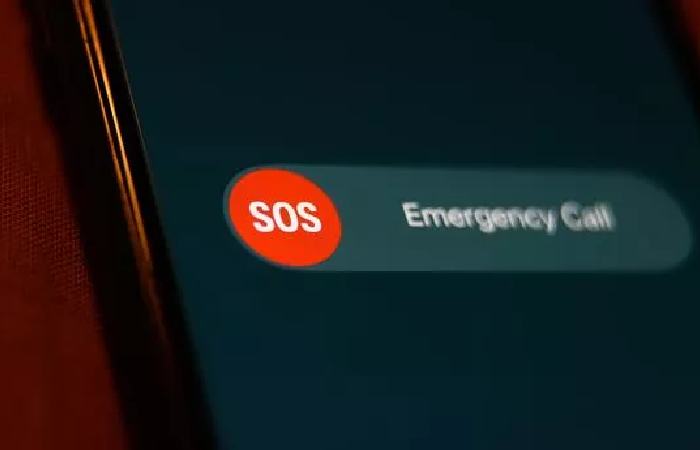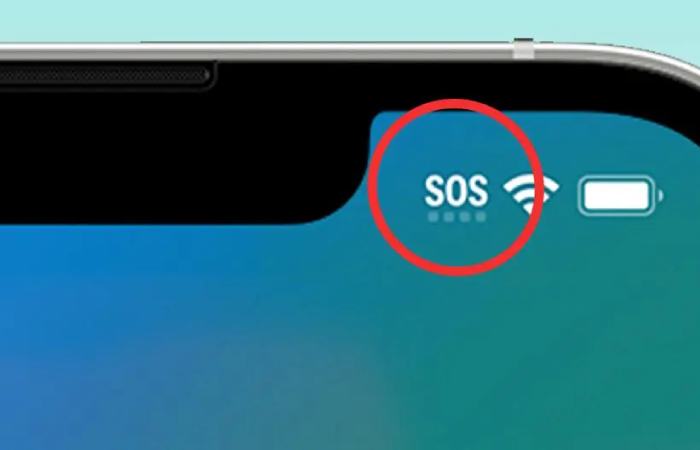Why Is My Phone On Sos
The “SOS” message display appears on your iPhone screen when driving across long, empty highways and taking subway rides. There is no reason for concern regarding this display. You have entered a location that no longer has your regular cellular connection, yet you can only dial emergency numbers.
When you return to an area with strong cell coverage, the phone service may not engage you. The SOS status continues showing on your screen no matter how much you lift your phone into the air in search of a connection.
The good news? You can fix it. This section explains how to manage the iPhone Emergency SOS satellite functionality and provides a solution when your device gets activated.
Take advantage of this opportunity to understand Emergency SOS satellite service for 911 calls while stopping the automatic 911 dial by your iPhone.

Table of Contents
What exactly is Apple’s Emergency SOS via Satellite?
Using satellite capabilities, Emergency SOS is a built-in Apple iPhone 14 interface that permits direct contacts to emergency services for location sharing when cellular networks are unavailable.
A red SOS icon will appear in the screen corner of your iPhone whenever you lose wireless connectivity, enabling Emergency SOS satellite detection for seeking emergency aid.
The satellite-based Emergency SOS feature appears on new iPhone 14 devices, yet its satellite communication service requires a cellular connection. The feature does not operate equally to Emergency SOS via satellite.
Understanding SOS Mode on Your Phone
SOS mode is a feature designed to help during emergencies, but it often confuses users. When your phone displays SOS or similar messages like “No Service” or “Searching,” it might mean that your device isn’t connecting to your carrier properly. This situation can arise due to network issues or even a simple software glitch. The keyword Why Is My Phone On Sos appears for many users searching for answers.
Many smartphones now include an SOS feature that automatically calls emergency services if certain conditions are met. The feature is intended for safety, but it can activate unexpectedly when there’s a weak signal or if the phone misinterprets network data. This behavior can be puzzling, especially if you believe you have service. The situation calls for a closer look into what triggers these messages.
Several factors can contribute to the SOS display, ranging from hardware issues to configuration errors. Users might see “SOS only” or variations like “SOS with WiFi,” making it difficult to pinpoint the root cause. The feature is typically embedded in the operating system, meaning software updates or resets might resolve the issue. We explore these factors throughout this article.
A common misconception is that the SOS mode is a bug, but in many cases, it’s a protective measure when your phone cannot access a reliable cellular network. Some phones automatically switch to emergency mode when they detect that only emergency calls are possible. This process is designed to keep you safe until normal service is restored.
SOS Mode on Different Devices and Networks – Why Is My Phone On Sos
Different phone models and carriers handle SOS mode in their own ways. For instance, users with the iPhone 13 sometimes report, why is my phone on SOS iPhone 13? This could be due to a specific software setting or an issue with the carrier’s configuration for newer models. Each device might have a slightly different threshold for triggering SOS mode.
When it comes to specific networks, the experience can vary. For example, Verizon users often ask, why is my phone on SOS mode Verizon? Verizon’s network configuration, combined with regional coverage gaps, can sometimes force phones into emergency mode despite the appearance of service. Carrier-specific issues often play a significant role here.
The phenomenon isn’t limited to cellular service alone. Some users experience SOS mode even when connected to WiFi, prompting the question, why is my phone on SOS with WiFi? This can occur when the phone prioritizes WiFi calling and the WiFi signal is unstable or misconfigured. It’s an interesting twist on the issue and one that many have encountered.
Another frequent query is, why is my phone on SOS but I have WiFi? In these cases, while the WiFi might be functioning for internet access, the cellular connection necessary for regular calls might be compromised. The phone switches to SOS mode because it cannot establish a reliable connection with your carrier. This dual connectivity challenge often perplexes users.
It’s important to note that different operating systems have their own methods for handling connectivity issues. Whether you have an iPhone or an Android device, the SOS feature is there to ensure that emergency calls can still be made. Recognizing these device and network differences is crucial when addressing Why Is My Phone On Sos.
Common Causes of SOS Mode – Why Is My Phone On Sos
There are several reasons why your smartphone may fall into SOS mode. We have outlined the most common causes below, alongside practical advice on how to address each one.
-
Network Outages and Poor Signal Coverage
The complete absence of cell network coverage and fragile signal strength between these networks are the most common reasons leading to SOS mode activation. The lack of a cellular network can occur during any journey across rural terrain, remote walking paths, or briefly moving into interception-heavy buildings. Your phone remains in SOS mode until it hooks back into a network, even after entering a region with strong signal strength.
According to recent reports from nationwide outage incidents, the AT&T network disruptions led to your phones showing both SOS mode Time and ZDNet screens across the nation. When outages affect multiple areas, the wireless service provider ends the problem-solving process after all networks restore operations. Regular outage-prone areas will not benefit from this condition.
Troubleshooting Tip:
Check Your Surroundings: Confirm whether you are in a low-signal area. Moving to an open space or trying another part of the building can often help your phone reconnect to the network.
-
SIM Card Issues
A mis-seated or damaged SIM card can cause your phone to lose connection with your carrier, triggering SOS mode. This could result from physical damage, dirt on the contacts, or simply an improperly inserted SIM.
The SIM settings need adjustment for those who changed their devices since switching their carrier. Users of Android devices might encounter this exact problem when a combination of eSIM or physical SIM defects blocks their phone from making any calls beyond emergency services.
Troubleshooting Tip:
Reinsert or Replace Your SIM: Remove your SIM card, clean the contacts gently with a soft cloth, and reinsert it. If the problem persists, contact your carrier for a replacement SIM.
-
Software Glitches and Outdated Operating Systems
Software glitches are one of the primary reasons that activate SOS mode on cellular devices. The operating system contains bugs and out-of-date software that can disrupt your network connections, thus triggering incorrect SOS mode displays on your phone screen. The issue emerges more frequently when users do not install the latest phone operating system updates, although software updates address network connectivity problems and enhance device stability.
The Apple Support website recommends that iOS or iPadOS users update their devices to the current version to solve and avoid network problems. Android phone users must maintain their device operating systems to the latest version.
Troubleshooting Tip:
Update Your Operating System: Check for any available updates in your phone settings and install them. An updated operating system can resolve hidden bugs that might cause connectivity issues.
-
Incorrect Network Settings or Carrier Issues
Incorrect network settings or carrier-imposed restrictions could trigger the activation of SOS mode. The wrong setup of phone features, including turning off cellular data manually or activating power saving mode, creates network connection obstacles for your iPhone. Regular services on your device can shut down when carrier account problems or blocking from the carrier network occur due to unpaid bills or account restriction status.
Every smartphone requires carrier settings to learn how to connect to network services. According to Apple Support, users should examine their carrier settings through the Settings > General > About menu combination because this space might display the availability of a new update.
Troubleshooting Tip:
Reset Network Settings and Check Carrier Information: Go to your phone’s settings and reset the network settings. This step removes misconfigurations and forces your device to reconnect with your network. Also, contact your carrier to verify that your account is active and that your service has no restrictions.
-
Physical and Environmental Factors
Environmental conditions may influence the connection of your phone to the network. Excessive natural elements like high-rise properties, forested areas, and harsh weather situations create signal degradation. Modern network infrastructure can experience brief operational overload during emergencies or severe weather events to generate SOS mode alerts to mobile users.
According to documented reports, the phone displays SOS mode during instances of environmental interference that lasted until Macworld experienced signal improvement.
Troubleshooting Tip:
Move to a Different Location: If possible, change your location to see if the signal improves. Moving slightly, such as stepping outside or near a window, can boost your signal strength.
-
Emergency SOS via Satellite
Emergency SOS through satellite connects is available today because newer iPhones, starting with the iPhone 14 series, offer this functionality. Emergency SOS, through satellite, provides a communication method to reach emergency services in areas without cellular service. The new SOS functionality through satellite innovation causes user confusion because people incorrectly perceive it as a device error that puts the system in SOS mode. The device operates as a safety precaution that guarantees emergency contact possibilities in areas beyond cellular range.
Troubleshooting Tip:
Familiarise Yourself with Satellite SOS: If you are in a remote area, consult your device’s user manual or support pages (such as those provided by Apple Apple Support) to understand how the satellite SOS feature functions compared to regular cellular connectivity.

Advanced Fixes: No Service and Random SOS Occurrences
At times, your phone might display SOS mode randomly, even after you’ve tried the basic fixes. This leads to the question, Why did my phone randomly go into SOS only? Random occurrences may be the result of intermittent network outages or deeper software issues that require a factory reset or even professional help.
One common fix is to check for interference from external factors. A strong electromagnetic field, faulty SIM card, or even a damaged antenna can cause your phone to lose regular service. This can be particularly evident when you encounter How do I fix my phone if it says no service? In such cases, verifying the hardware can be as important as checking the software.
Using a detailed table can help summarize potential issues and their fixes:
| Issue | Possible Cause | Solution |
| SOS mode only | Weak signal or network outage | Restart phone; move to a clearer area |
| SOS with WiFi | Misconfigured WiFi calling | Check WiFi settings; update carrier settings |
| No Service or Random SOS | Software glitch or hardware issue | Update OS; reset network settings; contact support |
This table highlights some common scenarios and how you might address them, ensuring you have a clear plan when troubleshooting.
In some instances, the issue might be carrier-related. If your service provider is experiencing temporary outages, your phone may default to SOS mode until the network stabilizes. Contacting customer support can confirm whether an outage is affecting your area. Understanding this connection can help reduce the frustration of dealing with random SOS alerts.
Lastly, persistent problems might require a complete factory reset. This step should be taken with caution, as it erases all personal data on your device. Back up important files and settings before proceeding. Advanced troubleshooting, when combined with professional support, often resolves why Why Is My Phone On Sos even under stable conditions.
Conclusion: Why Is My Phone On Sos
You will probably be frustrated when you encounter SOS mode on your phone; however, the problem is resolved since weak network signals, SIM card issues, software malfunctions, and incorrect settings are common problems. Users must understand the common factors that can activate SOS mode on their Apple devices when using Emergency SOS via satellite.
Users who encounter SOS mode can usually resolve their phone issues by checking network configuration, replacing the SIM card, updating the system software, or relocating to more substantial signal locations. Learning about these factors enables quick emergency response and preparedness for potential incidents.

